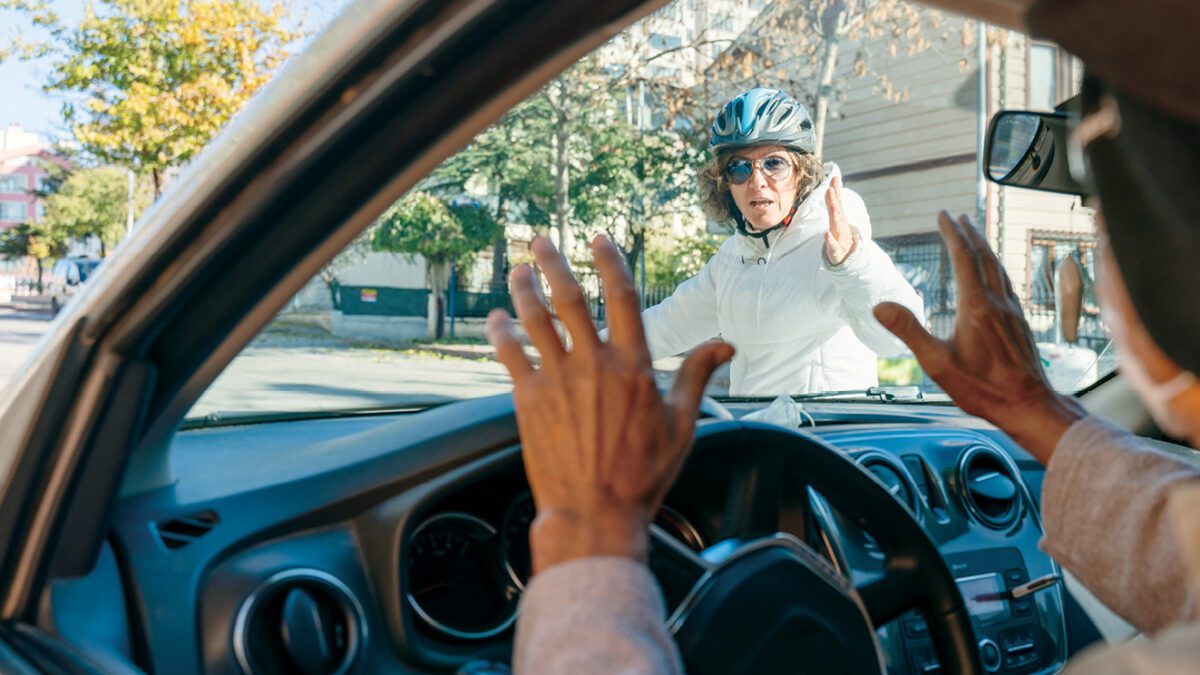Cycling and the law: A car caused you to crash, but didn’t actually hit you. Here’s what you can do
An invaluable guide to cyclists

A Tesla driver turned left abruptly across an oncoming lane of traffic. The motorist was headed toward a bike lane and ultimately a side street. A cyclist was in that bike lane. In order to avoid what she perceived as an impending collision, the rider took evasive manoeuvres but ended up crashing to the ground. She suffered a serious injury requiring surgery. And yet, no actual contact was made between the vehicles.
Since the car and the bike didn’t connect, Toronto Police refused to classify the incident as a motor vehicle collision. They denied the cyclist, who is now our client, access to the driver’s auto insurance information. Following surgery, she couldn’t access the help of a personal support worker. The rider’s recovery was threatened by lack of rehabilitation support, not to mention lost wage benefits.
Our office pointed out to the police that contact does not need to be made for a motor vehicle accident to occur. We also appealed to their compassion for an injured cyclist so that she could have the no-fault insurance information she needed.
Support for riders
I should note that even if police deny this information to cyclists, riders might still be able to find support. In Ontario, there’s the Motor Vehicle Accident Claims Fund. Alberta has the Motor Vehicle Accident Claims Program, while there’s the Uninsured Automobile Coverage in Newfoundland. These are supposed to help victims of crashes caused by uninsured motorists. In the case of our client, it might have been possible to seek accident benefits through the province because, without the driver’s insurance information in this situation, the motorist can be considered uninsured. Relying on these programs is not the best route, however. It is a waste of public funds as the driver did, in fact, have private insurance. Also, the benefits from private insurance tend to be better than those of public.
Examples of collisions
Ontario
The lawyer working with the police said that Ontario’s Highway Traffic Act defined a collision as requiring contact. There’s actually no definition of what a collision is in the Act. Further, an Ontario case released early in 2023 provided one example of how the police had it wrong. “There is ample support in the case law to demonstrate that contact with an automobile is not a required part of the definition of ‘accident,’” wrote Justice Steward.
British Columbia
In B.C., a court found that a driver’s negligent choice to drive up the wrong side of a garage’s ramp caused an approaching cyclist to brake suddenly, lose control and fall. The driver was liable for the crash despite no contact having occurred.
In a letter to the Toronto chief of police, we quoted both of these examples.
Important legal principles
It seemed the police were overlooking some important legal principles. In Ontario, there’s the Doctrine of Emergency, while B.C. has the Agony of Collision. In general, these similar concepts hold that when you need to act in the face of danger or in a situation that seems dangerous, you are not expected to use the same judgment you’d use in a calmer scenario. When your adrenalin is pumping and you have to act quickly, you’re expected to exercise only the care that an ordinary, prudent person would in the same circumstances.
Accident benefits
To the police, we also highlighted that the Ontario Insurance Act confirms that bodily injury can arise directly or indirectly from the use or operation of an automobile. In fact, people have been entitled to accident benefits (those our client so desperately needed) for slipping on ice while holding the handle of a car door or tripping off the roof of their trailer while cleaning it. These decisions were made after determining if the injury resulted during the normal use and operation of the vehicle, cleaning it or moving to open the door. Certainly, we pointed out to the Toronto police, a car turning into another road user’s path was just as much, if not more, a part of the normal use and operation of the vehicle than someone cleaning a trailer roof.
Being vigilant
Yet, still the lawyer representing the police dug in his heels. It wasn’t until our client bravely shared her story and highlighted the injustice with a local news channel that matters changed. We received a call the following day; our client was sent the insurance information she needed.
There is help available
It remains unclear how the Toronto police or other departments will handle near misses that result in cyclist crashes. Since we quietly received the necessary insurance information, our option of securing a court decision surrounding no-contact collisions and police obligations is unlikely. So, all of us in the cycling community should be aware that we may be denied insurance information if we dodge and crash trying to escape a dangerous driver. What should you do then in a near miss that leads to a crash? You should report the incident. Gather as much information you can: take photos of the driver’s licence plate and ask the driver for their insurance information. And rest assured, there is help out there for you.
Dave Shellnutt is the founder and managing partner of The Biking Lawyer LLP, lawyers for injured cyclists, thebikinglawyer.ca
If you liked this content, you may want to consider signing up for Canadian Cycling Magazine’s new members-only section. At $14.99 a year, it comes with digital access to current and past issues, exclusive member deals, and offers. Additionally, members can enjoy exclusive content, interviews, tips, and plans. You can interact and discuss racing, gear, and training with other members and Canadian Cycling Magazine staff.
For more information about our new members-only section, click here.
